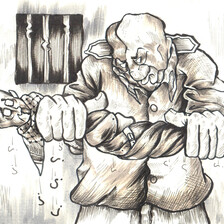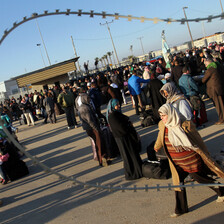The Electronic Intifada Gaza City 28 January 2015

Relatives of journalists who were killed during Israel’s summer attack on Gaza protest in front of the United Nations’ Gaza City headquarters in September 2014.
APA imagesMaysoon Abu Hayyin is not sure how she will provide for her one-year-old daughter Lana.
In July last year, Maysoon’s husband Ziad — a freelance journalist and online editor for the al-Kitaab newspaper — was killed during Israel’s attack on Gaza. Ziad had some money saved, yet Maysoon has not yet been granted authorization to access his bank account.
Maysoon, 22, was living with Ziad and Lana in the Shujaiya district of Gaza City. As Israeli forces launched widespread indiscriminate attacks in the area, Maysoon fled with her daughter to Egypt.
“When everyone fled, he stayed behind to do some work,” she told The Electronic Intifada. “He told us he’d come join us a few days later, but he couldn’t find transportation.”
Four days later Maysoon learned of her husband’s death while watching the news. Ziad was killed when Israel shelled his family’s home in Shujaiya. Ziad’s grandfather and cousin also died under the rubble.
“I was shocked,” she said, pausing, “and devastated.”
“Bloodiest year” for media workers
A total of 2,257 Palestinians were killed during Israel’s summer assault on Gaza, according to the United Nations monitoring group OCHA. Of that number, OCHA estimates 1,563 were civilians, including 563 children.
Entire neighborhoods throughout Gaza were left flattened, and Israel targeted hospitals, schools, mosques and other civilian infrastructure. In the Abu Hayyin family’s neighborhood of Shujaiya, homes were turned into massive piles of busted concrete and torn steel.
According to the Gaza Centre for Media Freedom, 2014 was the “bloodiest year” in history for Palestinian media workers. The watchdog group recorded 295 Israeli press violations in the occupied West Bank and Gaza.
Sixteen press workers — fifteen Palestinians and one Italian — were killed by Israel during the attack on Gaza.
Although Maysoon received a one-time sum from al-Kitaab for her late husband’s final paycheck, she later learned that she will not receive regular financial compensation.
“There just isn’t any money,” she explained.
Because al-Kitaab is affiliated with the Islamic University of Gaza, Maysoon has been granted a scholarship to study math and hopes that she will find work in order to take care of her daughter.
“Lana looks like her father very much,” she noted. “He was a good man. I never knew anyone so perfectly fitted for his job. He loved it.”
Repeatedly targeted
Ezz Zanoun, a freelance photojournalist whose work has frequently appeared on The Electronic Intifada, was one of dozens of Palestinian media workers injured during Israel’s assault on Gaza. “I luckily only had light injuries, but I was hurt several times,” he told The Electronic Intifada.
According to statistics provided to The Electronic Intifada by the Gaza Centre for Media Freedom, at least twenty-eight journalists dressed in press garb were seriously injured by Israeli forces in the course of their work.
“During the war, I had to carry all my equipment at all times,” Zanoun said. “[Palestinian] journalists are always aware that they may not return home to their wives or children because they live the massacres they are covering.”
Zanoun, who taught himself photography while covering Israeli attacks on Gaza, said: “The Israelis don’t consider [Palestinian] journalists. They attack us and shoot at us just like everyone else.”
The hardest part of covering the attack, he explained, “is hearing each day that another journalist was hurt or killed. And when we cover massacres and arrive at areas with martyrs, the first thing I think of is my family and how it could happen to them at any time.”
“I always thought I’d be next to die,” he said of last year’s onslaught. “The sound of [Israeli] rockets and bombs never stopped.”
Zanoun’s photography will be presented in an exhibition in Gaza City this week. “It is a collection of fourteen photographs that show the dangers journalists face in Gaza, especially during wartime.”
In addition to the record number of fatalities and injuries among media workers, rights groups have accused Israel of targeting media offices during the fighting in places across the narrow coastal enclave. At least seventeen offices were directly struck by shelling or missiles, according to the Gaza Centre for Media Freedom.
Muhammad Thuraya, news director of the Hamas-affiliated al-Aqsa TV, recalled the channel’s long history of being targeted by Israeli forces, particularly during the three major offensives against Gaza since 2008.
“The [Israeli] enemy attacks the entire Palestinian people and all of the Palestinian media, but there is always a focus on al-Aqsa,” Thuraya told The Electronic Intifada. “Just like the schools and the hospitals Israel has targeted, al-Aqsa TV was repeatedly directly targeted during the 2014 aggression.”
Thuraya added that Israeli forces directly struck five al-Aqsa TV offices and a storage unit last summer. Sameh al-Aryan, an al-Aqsa TV photographer, was killed on 30 July when Israel bombed the Shujaiya market.
Rami Rayan, his cousin, also a journalist, died in the same attack.
Ahmed Nasser, another al-Aqsa TV photographer, was injured when Israeli forces targeted the Italian Tower in Gaza City on 26 August.
Criminalizing journalism
Journalists in the occupied West Bank are also targeted by Israel.
Mustafa al-Khawaja, an al-Aqsa TV correspondent, was arrested by Israeli forces in October and detained for fifty days.
Charged with “incitement against the State of Israel” and “the promotion of terror ideas,” al-Khawaja was released on bail on 10 December, according to the Ramallah-based Palestinian Center for Development and Media Freedoms (MADA).
During one of al-Khawaja’s hearings, an Israeli prosecutor said that al-Aqsa TV has been considered an “illegal terrorist organization” since the beginning of October.
According to MADA, this is perhaps the first time that a media outlet has been classified by Israel as a terrorist group.
Nonetheless, al-Aqsa TV employees have also been the target of deadly attacks in the past. Two al-Aqsa TV journalists — Mahmoud al-Kumi and Hussam Salama — were killed by Israel during its eight-day war on Gaza in November 2012.
Israel and the United States “treat us as a terrorist channel because we protect [Palestine] with our voices, through news and pictures,” Thuraya of al-Aqsa TV said. “They attack us on social media — Facebook, YouTube, Twitter — and [Israel] attacks us with weapons.”
Patrick O. Strickland is an independent journalist and regular contributor to The Electronic Intifada. Find his reportage at www.postrickland.com. Follow him on Twitter: @P_Strickland_





